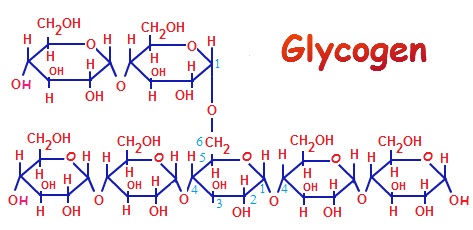Carbohydrates are organic compounds chemically defined as ketone or aldehyde derivatives of polyhydroxy alcohols.
They can be classified as:
- Monosaccharides (one sugar unit).
- Disaccharides (two sugar units)
- Oligosaccharides (2-10 units)
- Polysaccharides (>10 units)
Glucose is the monosaccharide found in the human body in any demonstrable quantity. However, it is extremely soluble in aqueous solutions and has a small molecular size, so it cannot be demonstrated in tissue sections. For this same reason disaccharides and oligosaccharides cannot be demonstrated either.
 |
| Source: https://media.istockphoto.com/vectors/structural-chemical-formulas-of-glucose-vector-id483245102 |
The human body stores glucose in the form of glycogen in the liver and skeletal muscle. Prompt fixation of the tissue is important for the demonstration of glycogen because of enzymatic breakdown post-mortem.
 |
| Source: https://www.ilovebicycling.com/wp-content/uploads/2016/02/is-glycogen-a-carbohydrate.jpg |
Other carbohydrates to be demonstrated are conjugated to either proteins or lipids.
The terminology and classifications of carbohydrates are inconsistent, so Culling (Handbook of Histopathological and Histochemical Techniques, 1974) used a system that classifies carbohydrates in four different groups for histochemical purposes.
GROUP I: NEUTRAL POLYSACCHARIDES (NONIONIC HOMOGLYCANS)
- Glucose-containing: glycogen, starch, cellulose.
- N-acetyl-glucosamine-containing: chitin.
This group gives a very positive PAS reaction and a negative reaction with the other frequently used carbohydrate stains (alcian blue, colloidal iron, mucicarmine).
GROUP II: ACID MUCOPOLYSACCHARIDES (ANIONIC HETEROGLYCANS).
- Carboxylated (COOH): hyaluronic acid, found in connective tissues and umbilical cord.
- Sulfated (OSO3H)and carboxylated (COOH):
- Chondroitin sulfate A (chondroitin-4-sulfate)
- Chondroitin sulfate C (chondroitin-6-sulfate), found in cartilage, chondrosarcomas, cornea, and blood vessels.
- Chondroitin sulfate B (dermatan sulfate), found principally in skin, also in connective tissue, aorta, and lung.
- Heparin, found in mast cells and the intima of arteries. - Sulfated only (COOH-free): human aorta and bovine cornea.
All polysaccharides in this group are acidic (anionic) and are thought to be attached to protein. The acid mucopolysaccharides are the so-called connective tissue mucins and are PAS-negative, but stain with alcian blue, colloidal iron, and mucicarmine.
GROUP III: GLYCOPROTEINS (MUCINS, MUCOID, MUCOPROTEIN, MUCOSUBSTANCES)
- Neutral: avimucoid (egg white), stomach mucin, Paneth cell granules.
- Carboxylated (COOH): sialoglycoproteins that contain sialic acid but no sulfate.
- Sialomucins found in submaxillary gland mucin, small intestine mucins, fetal mucins, the upper part of colonic crypts, and human sublingual gland.
- Serum glycoproteins.
- Blood group substances. - Sulfated (OSO3H) and carboxylated (COOH): sialoglycoproteins that contain both sialic acid and sulfate are found in colonic mucins of sheep and humans.
These are mostly "epithelial mucins", but some may occur in connective tissue. These glycoproteins are potentially but not necessarily PAS-positive.
GROUP IV: GLYCOLIPIDS
- Cerebrosides. Fatty residue bound to a carbohydrate structure.
- Phosphatides. PAS-positive, noncarbohydrate-containing lipids, including lecithin, cephalin, and sphingomyelin. This compound is included because of PAS-positivity.
The term acid mucosubstances is sometimes used to include both the acid mucopolysaccharides and the acidic glycoproteins, and although both groups react similarly with many of the histochemical techniques (e.g. alcian blue), they may react differently with others (e.g. PAS).
Other texts present different classifications of carbohydrates but I think this is a good simple classification for special stains purposes.